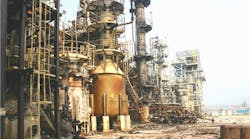On Dec. 3, 1984, over 40 tons of methyl isocyanate and other lethal gases including hydrogen cyanide, leaked into the northern end of Bhopal, killing over 3,000 people in its immediate aftermath and causing ongoing health issues for thousands more. More recently, a large explosion and fire that took the lives of two workers and injured several more at the Bayer CropScience plant in Institute, W. Va., in August 2008 was caused by a thermal runaway reaction during the production of an insecticide containing methyl isocyanate.
OSHA's new National Emphasis Program for isocyanates will target the serious health effects from occupational exposure to isocyanates. OSHA develops national emphasis programs to focus outreach efforts and inspections on specific hazards in an industry for a 3-year period. Through this NEP, OSHA will focus on workplaces in manufacturing, construction and maritime industries that use isocyanate compounds in an effort to reduce occupational illnesses and deaths.
“Workers exposed to isocyanates can suffer debilitating health problems for months or even years after exposure,” said Assistant Secretary of Labor for Occupational Safety and Health Dr. David Michaels. “Through this program, OSHA will strengthen protections for workers exposed to isocyanates.”
Isocyanates are chemicals that can cause occupational asthma; irritation of the skin, eyes, nose and throat; and cancer. Deaths have occurred due to both asthma and hypersensitivity pneumonitis from isocyanates exposure. Respiratory illnesses also can be caused by isocyanates exposure to the skin. Isocyanates are used in materials including paints, varnishes, auto body repair and building insulation. Jobs that involve exposure to isocyanates include the spray-on polyurethane manufacturing of products such as mattresses and car seats, and protective coatings for truck beds, boats and decks.
OSHA’s Web page on isocyanates provides additional information on recognizing potential hazards, as well as OSHA standards that address isocyanates in the general, construction and maritime industries.
Guide for Safe Use of Isocyanates
The Institut de Recherche Robert-Sauvé en Santé et en Sécurité du Travail (IRSST), a research organization in Quebec, has published the Guide for Safe Use of Isocyanates - An Industrial Hygiene Approach.
Since isocyanates cause most occupational asthma cases in Quebec, a guide was developed in 2000 to facilitate the safe use of isocyanates. In the past 10 years, industry has introduced new applications of isocyanates, greatly increasing the number of workers potentially exposed to them. By conducting a review of the scientific literature and consulting manufacturer databases, the researchers updated scientific and technical knowledge in this area, particularly toxicological data, regulations, processes and ways of controlling exposure.
Preventing exposure to isocyanates is a critical step in eliminating the health hazard. However, because of the wide range of isocyanates present in industry, and because their physical and chemical properties and the polymerization processes are so diverse, environmental assessment of exposure remains a challenge. The IRSST guide recommends an approach that starts with gathering of information on isocyanates in the workplace and ends with the implementation of controls and of means for evaluating the efficiency of those controls.
“Assessing exposure to isocyanates is a challenge, for several reasons: the wide variety of chemicals used, regulation limited to only a small fraction of them and exposure to them in the form of aerosols or vapors, depending on the process and on the physical and chemical properties of the substances,” stated the IRSST. “This risk is already very complex, but there is the added risk of exposure due to thermal degradation of these polymers and to residual quantities of unreacted isocyanates in the finished product.”
